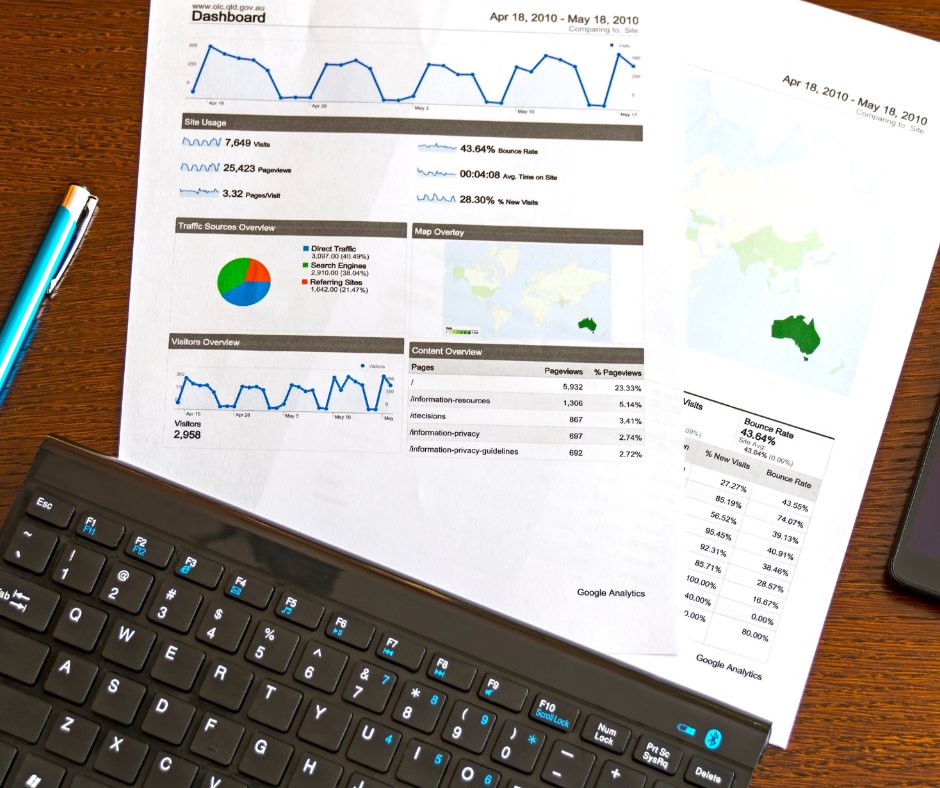We live in a world where your website is often your first salesperson, your 24/7 storefront, and your credibility badge. But most founders and marketers’ glance at website analytics once in a blue moon, if at all.
The truth? Your website analytics is a goldmine.
It tells you who’s visiting, what they care about, where they’re leaving, and whether your marketing dollars are working. Yet many brands don’t dig deep enough. They obsess over vanity metrics like total visitors or likes but miss the numbers that actually move revenue.
So, let’s flip the script. Whether you’re a startup hustling for traction, a B2B firm chasing leads, an e-commerce store optimizing conversions, or a B2C brand building awareness, here’s what your website analytics is really telling you and what you should be paying attention to.
Why Website Analytics Matter More Than You Think
- 90% of all data ever created has been generated in the last two years. That includes every click, scroll, and abandoned cart on your website.
- Companies that use data-driven strategies are 23x more likely to acquire customers (McKinsey).
- If you’re not measuring, you’re guessing, and guessing is expensive.
Analytics isn’t just for big corporations. Even the smallest startup can pull powerful insights from free tools like Google Analytics 4 (GA4), Hotjar, or Microsoft Clarity.
Now, let’s zoom into different types of businesses and what they should be tracking.
If You’re a Startup Website
For startups, the website is usually ground zero. Investors, early adopters, and journalists often judge you based on those first five seconds on your homepage.
What to look at:
- Traffic Sources: Where are people finding you—LinkedIn posts, Google search, referrals from accelerators, or direct traffic?
- Example: A UAE fintech startup noticed that 40% of their site traffic was coming from LinkedIn, but they weren’t doubling down on that channel. Missed opportunity.
- Bounce Rate / Engagement Rate: Are visitors staying long enough to understand your value? If most leave after 10 seconds, your messaging isn’t landing.
- Top Pages: Which pages get the most visits—your pricing page, blog, or careers page? If your “About Us” is trending, people are curious about your story—lean into it.
- Geography: Are you attracting the right region? If your solution is UAE-focused but 70% of traffic is from Africa, your targeting needs refinement.
What startups often miss:
Not setting up conversion tracking. You should measure micro-conversions like newsletter sign-ups, demo requests, or PDF downloads—not just “traffic.”
If You’re a B2B Website
For B2B, the website isn’t about mass traffic—it’s about quality leads and authority building. Decision-makers research silently before they ever reach out.
What to look at:
- Time on High-Intent Pages: Are prospects spending time on “Case Studies,” “Pricing,” or “Industries We Serve”? If yes, that’s buying intent.
- Form Conversions: What’s the percentage of people filling out “Contact Us” or “Book a Demo” forms? Even small tweaks—like fewer form fields—can increase conversion by 20%.
- Company-Level Analytics: Tools like Albacross or Clearbit can reveal which companies visited your site, even if they didn’t fill out a form. That’s gold for sales teams.
- Content Pathways: Did visitors read a blog before hitting “Contact Us”? If yes, that blog is doing the heavy lifting—invest in more of that content.
A Vancouver-based B2B consulting firm discovered through GA4 that 70% of conversions came from visitors who first read at least 2 blog posts. They shifted budget into content instead of cold ads and doubled lead quality.
What B2B brands often miss:
Tracking scroll depth and click maps. You’ll know if decision-makers are actually reading those long case studies—or just skimming.
If You’re an E-Commerce Website
For e-commerce, analytics is literally the difference between profit and loss. Every click can be tied to revenue.
What to look at:
- Cart Abandonment Rate: Industry average is a staggering 70% (Baymard Institute). If you’re above that, check your checkout flow—too many steps, hidden shipping costs, or limited payment options can kill conversions.
- Conversion Rate (CR): Globally, the average is 2-3%. If you’re below that, you have a UX, trust, or pricing issue.
- Top Exit Pages: If everyone is leaving at the shipping page, you know exactly what to fix.
- Customer Lifetime Value (CLV): Which traffic sources bring repeat buyers? Facebook might give cheap clicks, but Google Ads might bring high-CLV customers.
For reference, a UAE fashion brand realized that 80% of its revenue came from mobile—but its mobile checkout flow required 5 screens. After streamlining, conversions jumped 40%.
What e-commerce brands often miss:
Tracking site speed and mobile performance. Google says 53% of users abandon sites that take more than 3 seconds to load. That’s money left on the table.
If You’re a B2C Brand
For B2C brands (think lifestyle, F&B, or consumer services), websites are often about awareness and engagement, not just direct sales.
What to look at:
- Brand Search Volume: Are more people finding you by name? That means your campaigns are building awareness.
- Event Tracking: Are users watching your brand videos, downloading menus, or signing up for loyalty programs?
- Demographics & Interests: Are your visitors who you think they are? If your target is Gen Z but 60% of traffic is 40+, your messaging is misaligned.
- Cross-Channel Attribution: Did users first see you on Instagram but later convert via Google search? Analytics will show the journey.
A B2C food delivery startup discovered that most site visits happened during office lunch hours (12–2 pm). They shifted their ad budgets to peak hours—and cut cost-per-order by 25%.
What B2C brands often miss:
Not tracking offline conversions. If someone books online but pays in-store, connect POS data back to website analytics for the full picture.
(If you’re enjoying this article, you might like to subscribe to our bi-weekly email newsletter AMPlify. We share new blog articles, videos, and valuable ideas on AI, Marketing and Performance insights to grow your business. We assure you that we will never spam you, sell annoying courses or packages, or bug you with anything non-useful.
The Most Overlooked Metrics (Across All Websites)
- Site Search Queries: If people are searching “refund policy” on your site, make that info clearer upfront.
- Device Mix: Are most visitors on mobile, but you’re designing for desktop?
- Behavior Flow: Where do users drop off most? If 50% leave after the homepage, you need a better hook.
- Returning vs. New Visitors: Are you building loyalty, or just attracting one-time traffic?
- Goal Funnels: Have you set up step-by-step funnels in GA4? Without them, you’re blind to where people leak out.
Quick Fixes to Act on Today
- Startups: Add UTM tracking on every campaign. Know which channel is driving meaningful sign-ups.
- B2B: Reduce form fields from 8 to 4. Conversion rates typically increase by 35%.
- E-commerce: Add exit-intent popups with a discount code to rescue abandoned carts.
- B2C: Use heatmaps to see if people even scroll down to your CTA buttons.
Your Analytics = Your Roadmap
Your website isn’t just an online brochure. It’s a living, breathing system that constantly whispers secrets about your customers. The question is: Are you listening?
The next time you open your analytics dashboard, don’t just glance at “total visitors.” Dig deeper:
- Which pages drive the most conversions?
- Where are you losing customers?
- Are your campaigns targeting the right people?




